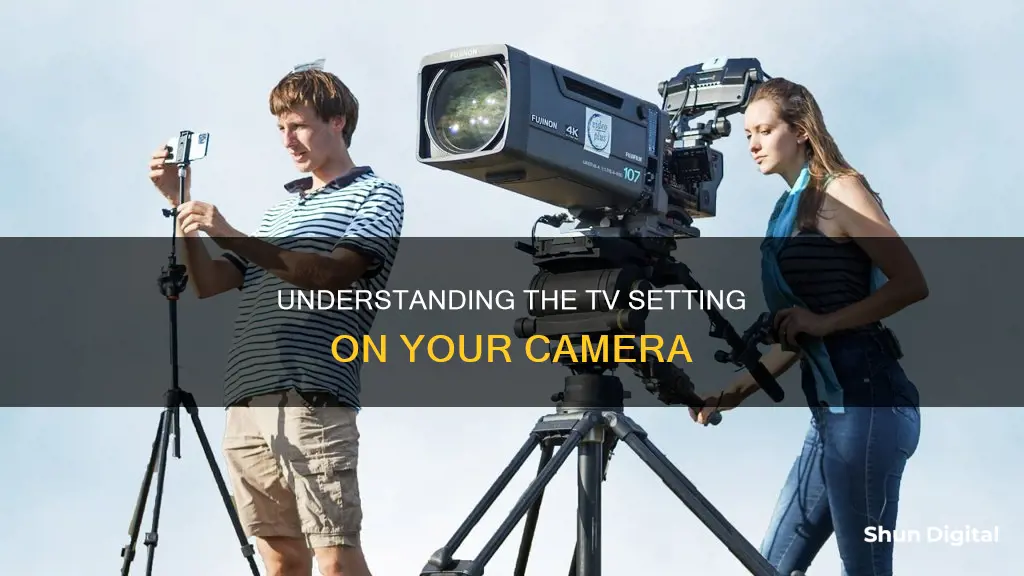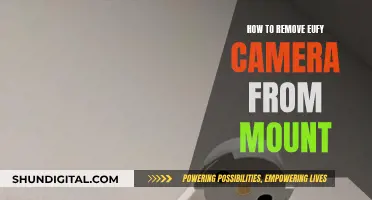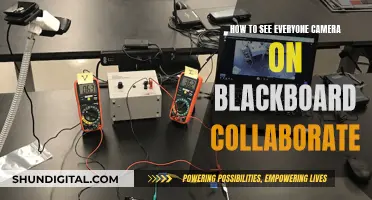
TV mode on a camera stands for Time Value, and it is also known as Shutter Priority Mode. In this mode, the user manually chooses a shutter speed, while the camera automatically adjusts the aperture size to correctly expose the image. This mode is useful for capturing motion without blurring, such as at a sporting event, or for creating a sense of movement and blur by using a slow shutter speed.
| Characteristics | Values |
|---|---|
| Full Name | Time Value |
| Abbreviation | TV |
| Other Names | Shutter Priority Mode |
| What It Does | User specifies a shutter speed, while the camera adjusts the aperture size to correctly expose the image |
| When To Use | When you want to freeze high-speed action with a fast shutter speed or create a sense of movement and blur in an image with a slow shutter speed |
| When To Avoid | When you want to control the depth of field |
What You'll Learn

TV mode is Shutter Priority Mode
"TV mode" on a camera stands for "Time Value" mode, which is also known as Shutter Priority Mode. In this mode, the user manually specifies a shutter speed, while the camera automatically adjusts the aperture size to correctly expose the image. Shutter Priority Mode is usually labelled as "'S' or 'Tv' on most digital camera mode dials.
Shutter speed is how long a camera's shutter stays open for each capture. A fast shutter speed can crisply capture a fraction of a second, while a long shutter speed can show movement over time with artistic blur. Shutter Priority Mode allows photographers to control the shutter speed without worrying about the aperture or ISO settings.
Shutter Priority Mode is useful in situations where capturing motion is important. For example, at a sporting event, a fast shutter speed can be used to capture athletes or players in motion without any blur, resulting in crisp and sharp images. On the other hand, a slow shutter speed can be used to intentionally create a sense of movement and blur in an image, such as blurring water or clouds in landscape photography.
Shutter Priority Mode is also beneficial when shooting video, as it allows for quick adjustments to different lighting situations while maintaining a consistent shutter speed. This mode is ideal for beginners who want more control over their camera settings but are not yet ready for full Manual mode.
Can Principals Monitor Teachers Through Surveillance Cameras?
You may want to see also

The user specifies the shutter speed
Shutter speed is one of the most important settings in photography, alongside aperture and ISO. It is the length of time the camera shutter is open, exposing light onto the camera sensor. Essentially, it’s how long your camera spends taking a photo. Shutter speed is measured in fractions of a second when they are under a second. For example, 1/4 means a quarter of a second, and 1/250 means one-two-hundred-and-fiftieth of a second (or four milliseconds).
Shutter speed has a significant impact on the brightness of an image. A long or slow shutter speed results in a brighter photo, as the camera sensor is exposed to light for a more extended period. Conversely, a fast shutter speed yields a darker photo, as the sensor captures light for a shorter duration.
The user can specify the shutter speed in TV mode, also known as Shutter Priority Mode. In this mode, the user manually selects a shutter speed, while the camera automatically adjusts the aperture size to achieve the correct exposure. This mode is typically used to freeze high-speed action with a fast shutter speed or create a sense of movement and blur with a slow shutter speed.
When using TV mode, it is important to consider the trade-off between shutter speed and depth of field. While TV mode is excellent for situations where shutter speed is critical, such as sports events, it may not be ideal when depth of field is a priority. For instance, in a group photo taken with TV mode in medium to low light, the camera may open up the aperture to capture more light, resulting in a shallow depth of field that causes some people to appear out of focus.
To summarise, the user specifies the shutter speed in TV mode, allowing them to control the shutter speed while the camera adjusts the aperture accordingly. This mode is versatile and can be used to capture fast-moving subjects with a fast shutter speed or create artistic blur effects with a slow shutter speed. However, photographers should be mindful of the trade-offs between shutter speed and depth of field when using this mode.
Apple Watch Camera: Fact or Fiction?
You may want to see also

The camera adjusts the aperture size
The letters "TV" on a camera stand for "Time Value", but the mode is more commonly known as Shutter Priority Mode. In this mode, the photographer specifies a shutter speed, and the camera automatically adjusts the aperture size to correctly expose the image.
The aperture size, or f-number, refers to the size of the opening in the lens through which light enters the camera. This opening can be made bigger or smaller, which in turn controls how much light gets through. A lower f-number indicates a larger aperture, which lets in more light and results in a shallower depth of field. Conversely, a higher f-number indicates a smaller aperture, letting in less light and resulting in a greater depth of field.
In TV mode, the user chooses a shutter speed, and the camera adjusts the aperture size accordingly to achieve the correct exposure. This mode is particularly useful in situations where the photographer wants to ensure a specific shutter speed, such as when capturing fast-paced action or motion. For example, at a sporting event, a photographer might want to use a fast shutter speed to capture motion without blurring. By setting the camera to TV mode and choosing a fast shutter speed, the camera will automatically adjust the aperture size to ensure the image is properly exposed.
TV mode is also beneficial when shooting video, as it allows for quick adjustments to changing lighting conditions. By locking in a specific shutter speed, the photographer can maintain a consistent look throughout the video. The camera will then automatically adjust the aperture size as needed to compensate for changes in lighting, ensuring that each scene is correctly exposed.
However, there are situations where using TV mode may not be ideal. For instance, if depth of field is a critical factor in the image, photographers should avoid using TV mode. This is because the camera may choose a very large aperture to let in more light, resulting in a shallow depth of field that could cause some elements in the photo to appear out of focus. In such cases, it would be preferable to use AV (Aperture Priority) mode, where the photographer can manually control the aperture size while the camera automatically adjusts the shutter speed.
Activating Your LG Smart TV's Camera: A Step-by-Step Guide
You may want to see also

Used to freeze high-speed action
TV mode, which stands for Time Value, is also known as Shutter Priority Mode. In this mode, the user manually chooses a shutter speed setting while the camera automatically adjusts the aperture for each shot. This is ideal for capturing high-speed action, as it allows the photographer to set a fast shutter speed to freeze motion without having to worry about adjusting the aperture manually.
When photographing a moving subject, it is essential to work quickly and capture sharp photos. By using TV mode, photographers can ensure they are hitting a specific shutter speed, which is crucial for freezing action. For example, at a sporting event, a fast shutter speed can be locked in to capture motion without blurring, while still allowing the camera to handle the overall exposure calculations for quick shots.
To freeze motion in photography, a minimum shutter speed of 1/250 of a second is typically required. However, this may need to be adjusted depending on the speed of the subject. For instance, capturing the motion of someone walking may require a shutter speed of 1/200s, while freezing the action during a Formula One race might demand a speed of 1/2000s.
In addition to shutter speed, other factors such as aperture and ISO play a role in freezing high-speed action. A wide aperture, such as f/5.6 or wider, can help blur the background and support the fast shutter speed. The ISO, which is the camera's sensitivity to light, can be increased for brighter images. For example, capturing a flying bird may require a shutter speed of 1/1200s, an aperture of f/4.0, and an ISO of 400.
By utilising TV mode and understanding the interplay between shutter speed, aperture, and ISO, photographers can effectively freeze high-speed action and create compelling images that capture moving subjects with sharpness and clarity.
Activating Your Apple Watch Camera: A Simple Guide
You may want to see also

Also used to create a sense of movement and blur
TV mode, or Shutter Priority Mode, is a setting on a camera that allows the user to specify a shutter speed, while the camera adjusts the aperture size to correctly expose the image. This mode is often used to freeze high-speed action with a fast shutter speed, but it can also be used to create a sense of movement and blur in an image by using a slow shutter speed.
When using TV mode, photographers can create a sense of movement and blur by choosing a slower shutter speed. This technique is often used in photography to convey a sense of motion or speed, such as in sports or action photography. For example, a photographer capturing a racing car or a runner might use a slow shutter speed to blur the background, giving the impression of speed and motion.
Another example of using TV mode to create movement and blur is in landscape photography. Photographers might use a slow shutter speed to capture the silky smooth effect of flowing water or to blur the movement of clouds in the sky. This technique adds a sense of dynamism and fluidity to the image, creating a more artistic and atmospheric result.
TV mode is also beneficial when shooting video, as it allows for quick adjustments to different lighting situations. By locking in a specific shutter speed, photographers can maintain a consistent look throughout the video footage, even as lighting conditions change. This ensures that the video maintains a cohesive aesthetic, and the photographer doesn't have to constantly fiddle with settings to achieve the desired exposure.
Additionally, TV mode can be used to create artistic effects by playing with different shutter speeds. For instance, a photographer might experiment with a very slow shutter speed to capture light trails from car headlights or the star trails in a night sky. This technique results in captivating images that showcase the movement of light, creating a sense of motion and energy in the final photograph.
In summary, TV mode on a camera, or Shutter Priority Mode, is a valuable tool for photographers who want to create a sense of movement and blur in their images. By manually selecting a slow shutter speed, photographers can introduce motion blur while the camera automatically adjusts the aperture to maintain correct exposure. This technique is particularly effective in sports, action, and landscape photography, as well as when shooting video or experimenting with artistic light effects.
Displaying Footage: 180-Degree Camera to TV Setup
You may want to see also
Frequently asked questions
TV stands for Timer Value, also known as Shutter Priority Mode.
In Shutter Priority Mode, the user manually chooses a shutter speed setting while the camera automatically adjusts the aperture for each shot.
Shutter Priority Mode is good for situations where you don’t need to control the depth of field but need to maintain a specific shutter speed. For example, at a sporting event, you might want to keep your shutter speed locked in pretty fast to capture motion without blurring.
Avoid using Shutter Priority Mode when your depth of field matters. For instance, if you’re taking a photo of a family in medium to low light, a camera set to TV mode might open up that aperture all the way to help grab extra light. This will make your depth of field so shallow that some of the people in the photo will be out of focus.







